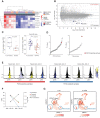Implementing a Functional Precision Medicine Tumor Board for Acute Myeloid Leukemia
- PMID: 34789538
- PMCID: PMC9762335
- DOI: 10.1158/2159-8290.CD-21-0410
Implementing a Functional Precision Medicine Tumor Board for Acute Myeloid Leukemia
Abstract
We generated ex vivo drug-response and multiomics profiling data for a prospective series of 252 samples from 186 patients with acute myeloid leukemia (AML). A functional precision medicine tumor board (FPMTB) integrated clinical, molecular, and functional data for application in clinical treatment decisions. Actionable drugs were found for 97% of patients with AML, and the recommendations were clinically implemented in 37 relapsed or refractory patients. We report a 59% objective response rate for the individually tailored therapies, including 13 complete responses, as well as bridging five patients with AML to allogeneic hematopoietic stem cell transplantation. Data integration across all cases enabled the identification of drug response biomarkers, such as the association of IL15 overexpression with resistance to FLT3 inhibitors. Integration of molecular profiling and large-scale drug response data across many patients will enable continuous improvement of the FPMTB recommendations, providing a paradigm for individualized implementation of functional precision cancer medicine. SIGNIFICANCE: Oncogenomics data can guide clinical treatment decisions, but often such data are neither actionable nor predictive. Functional ex vivo drug testing contributes significant additional, clinically actionable therapeutic insights for individual patients with AML. Such data can be generated in four days, enabling rapid translation through FPMTB.See related commentary by Letai, p. 290.This article is highlighted in the In This Issue feature, p. 275.
©2021 The Authors; Published by the American Association for Cancer Research.
Figures






Comment in
-
Functional Precision Medicine: Putting Drugs on Patient Cancer Cells and Seeing What Happens.Cancer Discov. 2022 Feb;12(2):290-292. doi: 10.1158/2159-8290.CD-21-1498. Cancer Discov. 2022. PMID: 35140175 Free PMC article.
References
Publication types
MeSH terms
LinkOut - more resources
Full Text Sources
Miscellaneous

